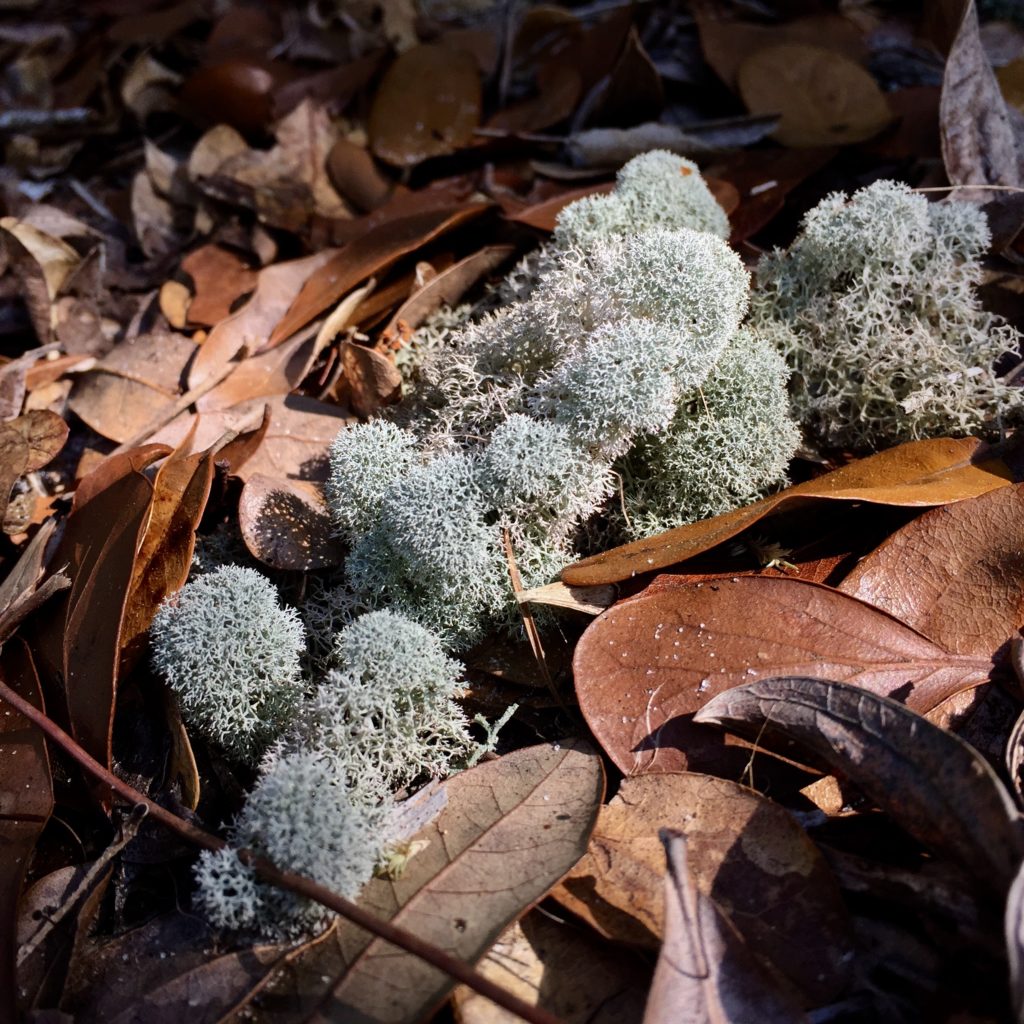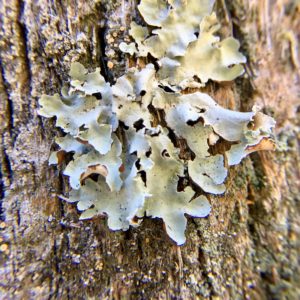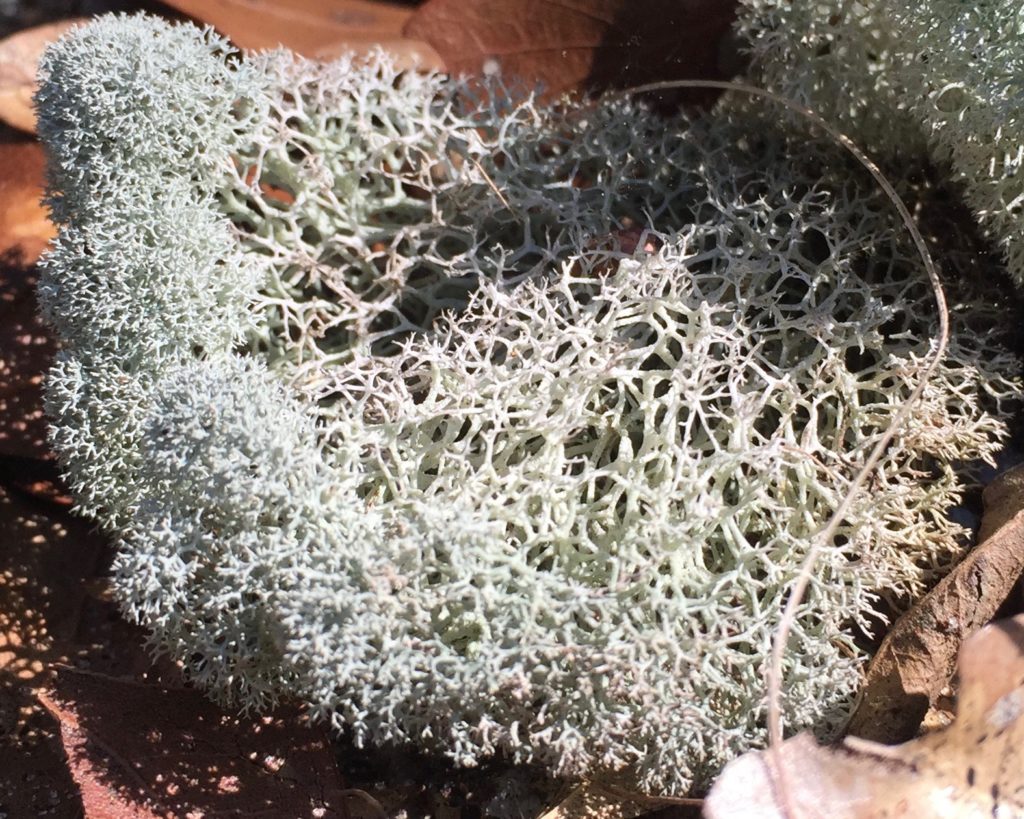When walking through the sandy scrubby areas at my two favorite natural areas here in Boca Raton (Yamato Scrub and Pondhawk), if I keep my eyes on the ground I can usually rely on encountering a fine group of reindeer lichen like this one:

But just what the heck are reindeer lichen? While I’ve known about this species (we’ll keep it simple and just call the symbiont a species) for at least a decade now (first encountered in my field classes from the Florida Master Naturalist Program), I’d never done much research on it. After encountering this beautiful reindeer lichen at Yamato Scrub this past January, though, I decided to correct this deficiency in my education. About the only bit of knowledge I have about lichens is that they are a symbiotic association of (usually) a fungus and an alga. So, yes, when a fungus and an alga take a lichen to one another, something wonderful happens.
[crickets chirping]
However, when I began reading about lichens, I soon realized why I’d not put much effort into it before: the literature devoted to them is for specialists indeed!
So, after quite a bit of reading, here’s what I’ve found.
The typical association of the organisms found in lichens is a fungus (which provides the structure or body of the lichen) and an alga (which provides the color). In technical terms, when found in lichens, the fungi are mycobionts and the algae are photobionts. Fungi derive all their nutrients from their substrate, while algae are capable of deriving energy directly from sunlight (through photosynthesis). The association works quite well, although the resulting organism is rather pollution-intolerant. Lichens are thus indicators of good air quality. (Hmm… Corals are also symbiotic organisms, and their fragile nature serves to indicate the health of marine waters. Maybe there’s something to this ecosystem idea.) In any case, one of the things that makes lichens interesting is that the different species are linked together by their mode of nutrition, not their ancestry. Apparently, it’s customary to name the lichen by the taxonomic name of the fungal part, ignoring the alga’s contribution to the affair.
Most people who have noticed lichens have probably seen them as spots or flakes of color on tree trunks or on rock surfaces:

Some lichens, though, appear to grow directly on the soil. And such is the case with Cladonia evansii, the powder-puff deer lichen.
Here, for example, is the brief description of the genus to which this species belongs in the most recent taxonomic work I could find (“Field oriented keys to the Florida lichens,” by Roger Rosentreter, Ann M. DeBolt, & Barry Kaminsky). I’ve highlighted in red the terms and concepts I’d never seen before in my life (notes are from various sources, chiefly here):
Description: Consisting of two parts, squamulose1 primary thallus,2 and an erect fruticose structure called podetia.3 Squamules small to medium. Podetia small to large. Pale greenish- gray to white to yellowish upper surface. Apothecia4 or soredia5 present. Never isidiate.6 Apothecia brown or red or tan. Spot tests7 various. Unique features: Sometimes intricately webbed as in C. evansii.
So you see, it’s as simple as that. Fortunately, Green Deane over at eattheweeds.com has a good write-up of C. evansii here, including the various ways people have prepared it for eating and drinking, in case you need a break from the technical jargon (I know I do!).
The U.S. Forest Service has a very long page devoted to the Cladonia group of lichens, although they don’t include the southern-dwelling C. evansii in the list (they focus on its northern cousin, C. rangiferina). What they describe, though, helps me wrap my head around the anatomy of the lichens in this group. From their write-up of Cladonia:
The lichen body, or thallus, is a composite structure of fungal and green algal cells. The primary reindeer lichen thallus is prostrate and squamulose (comprised of scaly, flaky, rounded pieces). The secondary thallus (podetium) is more conspicuous, being upright and fruticose. Fruticose forms are three-dimensional and have been described as shrubby and/or stringy. Podetia are hollow, highly branched, and capable of trapping wind-blown algae. They grow upward at the tip and die back at the base, similarly to sphagnum and other mosses. The spore-producing fungal bodies (apothecia) are produced at the tips of the podetia.
Anyway, what we need to know here is that the puffy part of the powder-puff deer lichen is the secondary thallus or podetium. It’s the rounded bit that forms the powderpuff part of the organism. The primary thallus is the horizontally growing inconspicuous bit.
Other lichens have other growth forms: folicose (leaf-like, as in the lichen on the cabbage palm near the top of this post); fruticose (shrubby), like the one we’re talking about here; and crustose (crusty).
Here’s a close-up of one of the clumps where you can get a better view of the podetia, so you can see how they grow in an “intricate web” as noted by Rosentreter and colleagues:

There’s a related species of lichen here in Florida, Cladonia subtenuis, that looks very similar, but the tips of the fruticose bits are less compact.
A third species, C. perforata, also exists here and is endangered. It’s restricted to the high, well-drained sands of rosemary scrub in Florida; I suspect it exists on some sites here in southern Palm Beach County, but I haven’t found it yet—the closest known site is Jupiter Ridge Natural Area. According to an information page from the Archbold Biological Station, “C. perforata was the first species of lichen to ever become federally listed as an endangered in the United States. C. perforata differs developmentally from other fruticose lichens, by having its branches derived from spore-producing structures called apothecia, rather than from the primary body (USFWS 1999).”
Lichens tend to grow on trees or rocks or in areas that are, at least seasonally, so hot, sterile, dry, or otherwise inhospitable that nothing else can make a go of it. In polar and subpolar areas, they can even comprise the dominant autotroph (self-feeding organism, usually translates as “plant,” although only the algal partner in a lichen can be considered a plant in any strict sense). In this case, they actually grow on the sand. Or, actually, on a soil crust.
What’s a soil crust? Well, my friend, that is a deep rabbit hole indeed. If you’re going to go down there, here is a description from the Archbold Biological Station’s website (emphasis added):
Biological soil crusts. In drier regions of the world, soil microorganisms form what are known as biological soil crusts. Because of their hidden nature, these crusts have been termed cryptogamic, cryptobiotic and microbiotic. Crusts are created when soil organisms cause the uppermost layer of soil to solidify into a single, cohesive layer. The “glue” that holds the soil together is made up of the living organisms themselves together with the sticky substances they excrete and leave behind as they move through the dry soil. Biological soil crusts are a well-known feature of deserts in the southwestern United States and have only recently been recognized in the southeast. Crusts in Florida scrub are unique because they occur in a wet climate where dry conditions are caused by rapid drainage of water through sandy soils.
See how far a simple nature walk can take you? I’ll have to read a lot more about soil crusts before I can do justice to them here.
Related Images:
- In squamulose lichens, the thallus is composed of usually small, flat, usually massed, often overlapping scales—”squamules.”
- The “vegetative” body of a lichen, including both the fungus (mycobiont) and algal cells (photobiont), but excluding any sexual fruitbodies.
- Lichenized, stemlike portion of an apothecium, or, notably in Cladonia, the upright, often branched or cup-like structure arising from the primary thallus.
- An ascomycete sexual fruitbody (ascocarp) which is usually cup- or saucer-shaped, sometimes convex. Fungi with apothecia as their fruiting bodies are termed “discomycetes.”
- microscopic clumps of algal cells surrounded by fungal threads which emerge from the lichen surface as a powder
- (plural: isidia) (adjective: isidiate) An asexual propagule enclosed in a cortex, containing fungal tissue and the phycobiont. Isidia are budded off from the thallus cortex and are variously peg-shaped, cylindrical, coral-like or spherical.
- Analysis used to help identify lichens. It is performed by placing a drop of a chemical on different parts of the lichen and noting the color change associated with application of the chemical

Hello! I was a biking a trail in the Greenway Cross area near the Land Bridge over I-75 when I discovered a blanket of beautiful little puff balls on the forest floor. They looked like “forest popcorn”. Being a curious person, I wanted to identify what they were. They didn’t appear to be a fungi so moss or lichen came to mind. I researched lichen and found the Reindeer lichen which it look very much like but I wasn’t sure it grew in this climate, although the source said hot climates too. Then I found your page and “powder puff deer lichen” so that must be it. I have photos if you want me to share them, Reply to my email and I will send you the photos. They were so attractive carpeting the forest floor and I hope you can confirm if they are indeed powder-puff deer lichens. Are they they same as Reindeer lichens-question. Thanks for any help you can give me!!